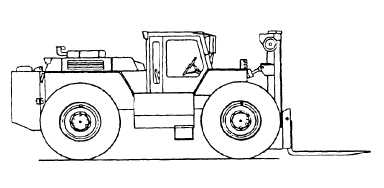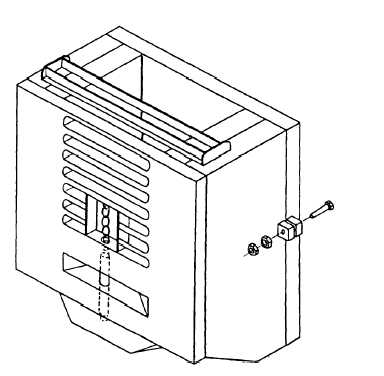transmission for smooth acceleration, deceleration, and
easy handling.
LIFT-KING FORKLIFT
The NCF has two types of lift-king forklifts (fig.
8-8) rated at 12K and 16K. These two models provide
a lifting capacity of 12,000 to 16,000 pounds at a 48-inch
load center to a height of 120 inches. The lift-king
forklift is equipped with forklift oscillation, load side
shift, lift interrupt, fork positioning, four-wheel and
two-wheel-crab steering selection, and counterweight
lowering.
The lift-king forklift is equipped with an inching
control that is controlled by the inching pedal located to
the left of the brake pedal. Depressing the inching pedal
slightly varies the amount of oil pressure in the
transmission, allowing the forklift to be “inched” along
slowly while the engine is operated at high speed for fast
lifts. When the inching pedal is depressed fully, the
transmission is disengaged.
NOTE: Do not use the inching pedal as a clutch
and under high-torque requirements.
The mast of the lift-king forklift is equipped with a
lift interrupt device that prevents lifting the fork
assembly above 43 inches from the ground. This is a
safety device to prevent raising the mast while inside an
aircraft and causing extensive damage. To lift loads
higher than 43 inches, you must press the red-colored
manual lift interrupt override button. This button allows
the forks to attain their maximum lift height when
required.
The lift-king forklift is air transportable; however,
where the load per axle weight cannot be exceeded, the
front carriage assembly and rear counterweight must be
removed. The procedure of carriage removal is as
follows:
1. Lower the forks to the ground and tilt the mast
slightly forward to produce slack in the lifting chains.
2. Remove the lower chain anchor pins.
3. Raise the mast above the carriage rollers and
back the forklift out, leaving the forks and carriage on
the ground.
NOTE: For reinstallation, the procedures are
simply reversed.
The procedure for counterweight removal is as
follows:
1. Remove the two bolts (one on each side of the
forklift) that secures the counterweight (fig. 8-9).
2. Lower the counterweight lifting arm to rest the
counterweight on the ground (hydraulic control lever is
located in the back of the operator’s cab to the right of
the seat).
3. Remove the pin from the shackle to disconnect
the arm from the counterweight. Remember: Store the
bolts and the pin in the toolbox.
4. Drive the forklift away from the counterweight.
NOTE: When the lift-king forklift is transported on
a tractor-trailer, seal the exhaust pipe to prevent
autorotation of the turbocharger turbine due to wind
velocity. Failure to do so can result in damage to the
turbine bearing due to lack of lubrication.
Figure 8-8.—Lift-king forklift.
Figure 8-9.—Counterweight.
8-5



